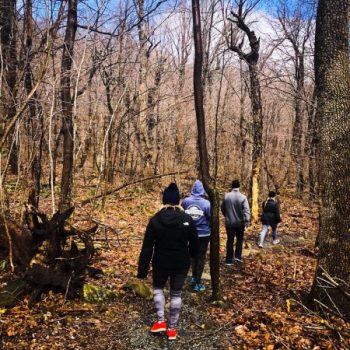
Winter Hiking Tips
You can still take comfort in the outdoors in cooler temperatures; The key is to be prepared
This year, many of us turned to the outdoors—and hiking, in particular—as a way of dealing with the stress and isolation of the COVID-19 pandemic. Spring, summer, and fall saw record attendance at our state and local parks. Now that winter is here and restrictions on indoor activities are ratcheting up, you may be wondering what to do.
Our advice? Keep on hiking! Winter hiking can be refreshing and relaxing—it just requires some preparation and a few precautions.
In our region, we’re unlikely to encounter dramatic snow drifts or extreme low temperatures while on our parks’ trails, but our winter weather can still prove formidable enough that we should be prepared when heading out for a hike.
Here are a few tips for fun, safe winter hiking:
Before You Head Out
- Make sure the trail/park is open and share your itinerary. Parks often operate under reduced hours in the winter, but that’s especially true this year. Verify the operating hours of your favorite parks or trails before heading out. When heading into the woods, always let someone know where you’re going and how long you expect to be there.
- Check the weather. Ideal conditions for winter hiking are when it’s sunny and the temperature is just below freezing, ensuring that the trails are firm and not muddy from rain or thawing snow. Keep an eye on the forecast for potential storms or extreme temperature drops and time your hike to avoid them. Heading out on an unusually warm winter day? Consider a location with paved or gravel trails. Hiking unpaved trails after a recent thaw can degrade and erode them.
- Dress in layers. Avoid hypothermia or overheating by dressing in several warm layers that allow you to adapt to conditions. A moisture wicking base layer that pulls sweat away from the body is important—being wet while out in the cold can be dangerous. Keeping a set of dry clothes, a blanket, and thermos of your favorite hot beverage in your car are handy for warming up quickly at the end of your hike.
- Wear proper footwear. Sturdy hiking shoes that keep your feet warm and dry make for a happy hiker. If you’re heading to a trail that’s likely to be icy, consider additional tread for your boots and/or trekking poles for extra stability.
While You’re On the Trail
- Stay hydrated and pack a snack. You’ll still sweat even though the temperatures are cooler. Be sure to carry enough water to keep you hydrated. Exercising in cooler temperatures burns more calories, so carry plenty of easy to eat snacks to keep your energy up.
- Keep an eye on the time. Winter’s early sunsets mean less daylight for hiking. And, unlike summer hiking, when you should avoid the sunniest part of the day to stay cool, in the winter you should plan your hike to get in the most sunshine. Hit the trails early in the day and be sure you’re off the trails before dark.
- Have fun!
Anne Arundel County has plenty of great places to enjoy a hike, including two publicly accessible properties protected forever by Scenic Rivers: the Bacon Ridge Natural Area in Crownsville and the Contee Farm on the campus of the Smithsonian Environmental Research Center in Edgewater.
